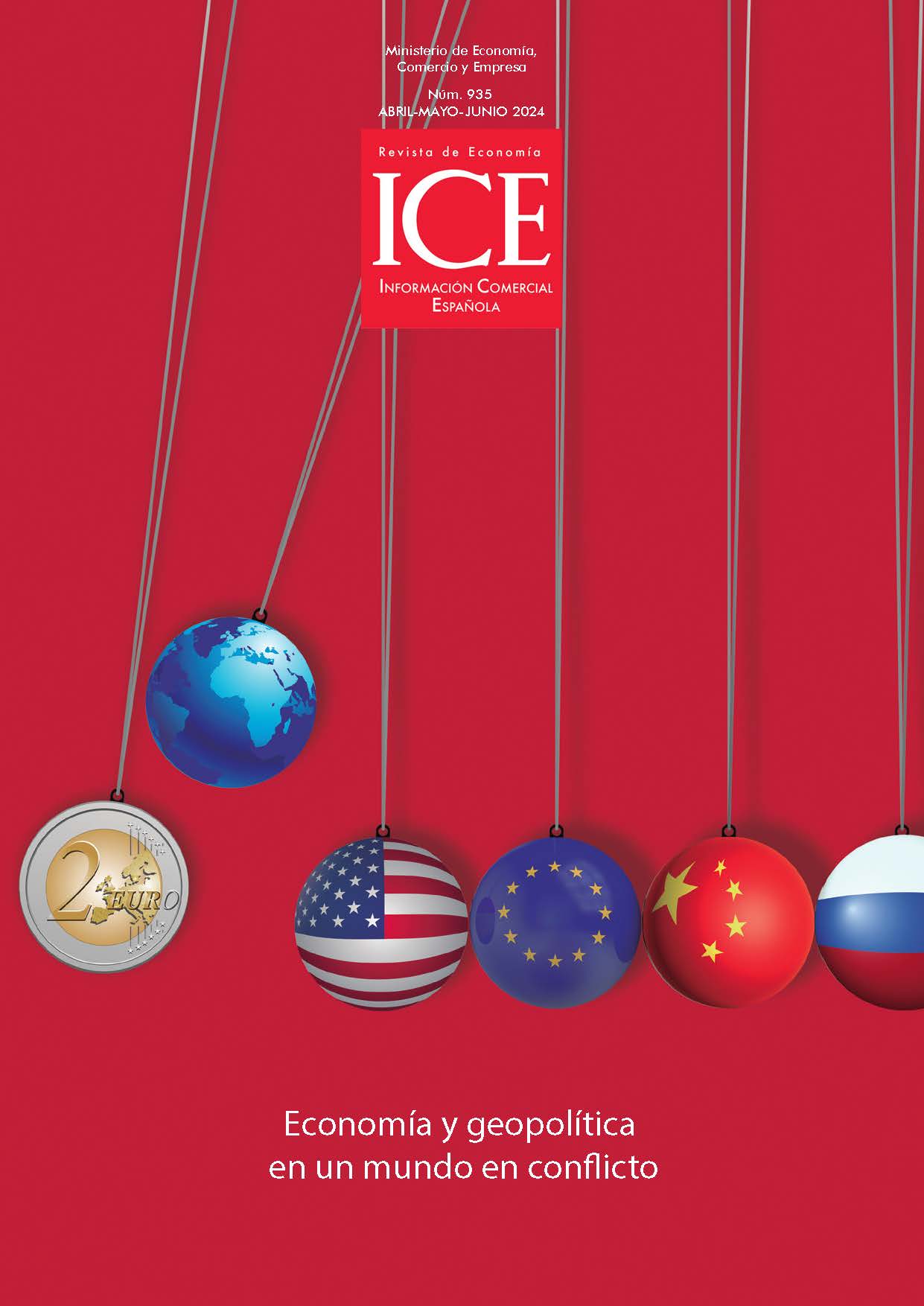Economía y geopolítica del sector energético: desde los combustibles fósiles a los minerales de la transición
##plugins.themes.bootstrap3.article.sidebar##
Descargas
##plugins.themes.bootstrap3.article.main##
Este artículo explora cómo en el complejo tablero geopolítico actual, la seguridad económica y energética se ha vuelto un objetivo prioritario. También muestra cómo la transición energética reduce la dependencia de combustibles fósiles, pero crea nuevas vulnerabilidades al aumentar la demanda de minerales críticos, sobre todo refinados y purificados, reconfigurando actores y dinámicas geopolíticas. El actual dominio de China en estos materiales plantea desafíos cruciales. En respuesta, los países occidentales buscan estrategias para reconfigurar las cadenas de suministro y atraer nueva inversión, pero estos intentos chocan con la dificultad y los costes de reducir la dependencia de China, surgiendo una serie de dilemas, como el que se enfrenta en cuanto al deseo de desacoplamiento con China y la necesidad de avanzar rápidamente en la transición energética.
##plugins.themes.bootstrap3.article.details##
- Pedro Antonio Merino García, Rebeca Albacete Sánchez-Mateos, José María Martínez Pérez, Juan Jesús Rubio Jareño, Recuperación económica y sector exterior español, algunas consideraciones , ICE, Revista de Economía: Núm. 924 (2022): La crisis de la COVID-19: el camino de la recuperación
Arezki, R., & Van der Ploeg, F. (2023). On the new geopolitics of critical materials and the green transition. In C. Gollier & D. Rohner (Eds.), Peace not Pollution: How Going Green Can Tackle Climate Change and Toxic Politics (pp. 199-211). CEPR Press. https://cepr.org/publications/books-and-reports/peace-not-pollution-how-going-green-can-tackle-climate-change-and
Bistline, J., Blanford, G., Brown, M., Burtraw, D., Domeshek, M., Jamil Farbes, J., Fawcett, A., Hamilton, A., Jenkins, J., Jones, R., King, B., Kolus, H., Larsen, J., Levin, A., Mahajan, M., Marcy, C., Mayfield, E., Mcfarland, J., Mcjeon, H., Orvis, R., Patankar, N., Rennert, K., Roney, C., Roy, N., Schivley, G., Steinberg, D., Victor, N., Wenzel, S., Weyant, J., Wiser, R., Yuan, M., & Zhao, A. (2023). Emissions and energy impacts of the Inflation Reduction Act. Science, 380(6652), 1324-1327.
BloombergNEF. (2024). China's Clean-Tech Dominance Grows Despite Onshoring Push. Bloomberg.
Boer, L., Pescatori, A., & Stuermer, M. (2021). Energy Transition Metals (IMF Working Papers No. 21/243). International Monetary Fund.
Bogmans, C., Pescatori, A., & Prifti, E. (2023). The Impact of Climate Policy on Oil and Gas Investment: Evidence from Firm-Level Data (IMF Working Paper No. 23/140). International Monetary Fund.
Calvo, G., Mudd, G., Valero, A., & Valero, A. (2016). Decreasing ore grades in global metallic mining: a theoretical issue or a global reality? Resources, 5(4), 1-14.
Chester, L. (2010). Conceptualising energy security and making explicit its polysemic nature. Energy Policy, 38(2), 887-895.
Evenett, S., Jakubik, A., Martín, F., & Ruta, M. (2024). The Return of Industrial Policy in Data (IMF Working Paper No. 2024/001). International Monetary Fund.
FMI. (2023). Geopolitics and Financial Fragmentation: Implications for Macro Financial Stability. In Global Financial Stability Report: Safeguarding Financial Stability amid High Inflation and Geopolitical Risks (pp. 81-101). International Monetary Fund.
Galbraith, J. K. (2023). The Gift of Sanctions: An Analysis of Assessments of the Russian Economy, 2022 – 2023 (Institute for New Economic Thinking Working Paper Series No. 204).
Grasso, V. B. (2013). Rare Earth Elements in National Defense: Background, Oversight Issues, and Options for Congress. CSR Report, R41744. Congressional Research Service.
IEA. (2021). The Role of Critical Minerals in Clean Energy Transitions. International Energy Agency.
IEA. (2023a). Renewables 2023. International Energy Agency.
IEA. (2023b). Total Demand for Selected Minerals by End Use in the Net Zero Scenario, 2021-2050. International Energy Agency.
IRENA. (2023). World Energy Transitions Outlook 2023: 1.5 °C Pathway, 1. International Renewable Energy Agency.
Javorcik, B., Kitzmüller, L., Mathew, S., Schweiger, H., & Wang, X. (2023). The green transition and geopolitical tensions. CEPR. https://cepr.org/voxeu/columns/green-transition-and-geopolitical-tensions
Kim, J., Panton, A., & Schwerhoff, G. (2024). Energy security and the green transition (IMF Working Paper No. 2024/006). International Monetary Fund.
McKinsey & Company. (2022). The raw-materials challenge: How the metals and mining sector will be at the core of enabling the energy transition.
Reuters. (2024, April 23). China can’t quit coal by 2040, researchers say, despite global climate goals. https://www.reuters.com/world/china/china-cant-quit-coal-by-2040-researchers-say-despite-global-climate-goals-2024-04-23/
Schmidt, T. S., Steffen, B., Egli, F., Pahle, M., Tietjen, O., & Edenhofer, O. (2019). Adverse Effects of Rising Interest Rates on Sustainable Energy Transitions. Nature Sustainability, 2(9), 879-885. https://doi.org/10.1038/s41893-019-0375-2
Sullivan, J. (16 de septiembre de 2022). Palabras del Asesor de Seguridad Nacional Jake Sullivan en la Cumbre Global de Tecnologías Emergentes del Proyecto Especial de Estudios Competitivos. https://www.whitehouse.gov/briefing-room/speeches-remarks/2022/09/16/remarks-by-national-security-advisor-jake-sullivan-at-the-special-competitive-studies-project-global-emerging-technologies-summit/
The Economist. (2023, September 11). How to avoid a green-metals crunch. The Economist.
Yergin, D. (2006). The Prize: The Epic Quest for Oil, Money, and Power. Free Press.


